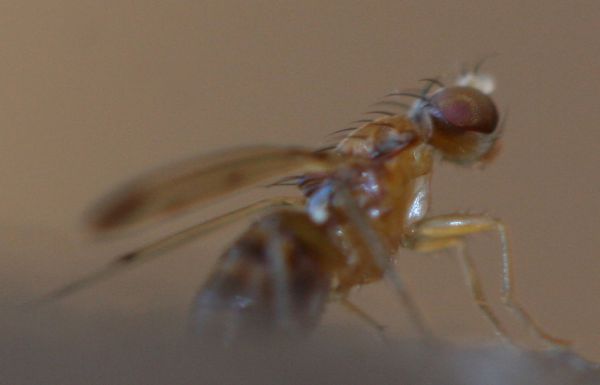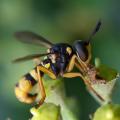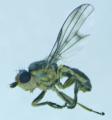Diptera.info :: Identification queries :: Diptera (adults)
Who is here? 1 guest(s)
|
fly for Jan Willem department?
|
|
| Nikita Vikhrev |
Posted on 01-10-2005 23:24
|
|
Member Location: Moscow, Russia Posts: 9306 Joined: 24.05.05 |
01 okt, Moscow region, 3-4mm. A few is visible (for me at least), but it acted like Palloptera sp. 
Nikita Vikhrev - Zool Museum of Moscow University |
|
|
|
| Paul Beuk |
Posted on 01-10-2005 23:38
|
|
Super Administrator Location: Netherlands Posts: 19311 Joined: 11.05.04 |
Yes, it is. Opomyzidae, genus Geomyza. Jan Willem, eat your heart out. 
Paul - - - - Paul Beuk on https://diptera.info |
| Nikita Vikhrev |
Posted on 02-10-2005 00:15
|
|
Member Location: Moscow, Russia Posts: 9306 Joined: 24.05.05 |
Thank you Paul. May be he explain me how to distinguish Opomyzidae from Pallopteridae  . .
Nikita Vikhrev - Zool Museum of Moscow University |
|
|
|
| Jan Willem |
Posted on 02-10-2005 17:09
|
|
Member Location: Waalwijk, The Netherlands Posts: 2134 Joined: 24.07.04 |
Hi Nikita, Paul is right about it being a specimen of the genus Geomyza [Opomyzidae]. Unfortunately your picture is not the best for the identification. But let me make a guess: - there seem to be one presutural and three postsutural dorsocentral setae. - both crossveins seem to be clouded, but not as conspicuously as in the tripunctata group [G. majuscula, G. nartshukae, G. tripunctata]. However the clouds are to distinct for G. venusta. - the colouration of the postnotum is not clearly visible, but it seems to be rather dark, but not entirely so. => probably not G. hackmani. - the banded appearance of the abdomen reminds me strongly of the female of G. balachowskyi. So my guess would be a female of Geomyza balachowskyi Mesnil, 1934. However to be sure you have to study sternite 8 (if it is indeed a female) or the sustylar lobe of the male genitalia (if it is a male). =============================================== How to distinguish Opomyzidae from Pallopteridae in the field? The wings of Pallopteridae are much broader than those of the Opomyzidae (especially those of the genus Geomyza are rather narrow). Most Opomyzidae have no post vertical bristles (only present in the genus Anamalochaeta which only occurs in the most northern part of the holarctis). The post vertical bristles are present in Pallopteridae. Well this is not an easy character to use in the field I suppose. Generally speeking, the Pallopteridae look more like Tephritidae, which is certainly not the case with Opomyzidae! |
|
|
|
| Nikita Vikhrev |
Posted on 02-10-2005 18:12
|
|
Member Location: Moscow, Russia Posts: 9306 Joined: 24.05.05 |
Thank you Jan. 1. Geomyza balachowskyi. I feel myself akward that you spend such attantion on this bad picture. 2. Not so easy for two families of different superfamilies! Than: 2.1. I have some keys now 2.2. I'll try to get rid of impression that it is me so stupid in this case. P.S. This Geomyza acted exactly like Palloptera saltuum ("gymnast wing's moving). Nikita Vikhrev - Zool Museum of Moscow University |
|
|
|
| Jan Willem |
Posted on 05-10-2005 09:28
|
|
Member Location: Waalwijk, The Netherlands Posts: 2134 Joined: 24.07.04 |
Hi Nikita, Yesterday I studied a specimen from Finland which looked similar to the one on your picture. The abdomen had the banded patern which you typically find in females of Geomyza balachowskyi.However, since the marking on the tip of the wing was rather extensive, I had my doubts about the specimen being G. balachowskyi. After treating the tip of the abdomen with a 10% KOH solution, I studied sternite 8. The specimen turned out to belong to G. hackmani Nartshuk, 1984 without doubt. The marking on the tip of the wing in your specimen also seems to be rather extensive. Furthermore in the Moscow region G. hackmani is probably much more common than G. balachowskyi. So I hereby let you know that it is more likely that your specimen belong to G. hackmani than to G. balachowskyi. My apologies for the confusion! By the way, the "gymnastic wing moving" is a behaviour I have seen frequently in both Geomyza tripunctata and G. balachowskyi (the two species of the genus Geomyza I most commonly find in The Netherlands). Jan Willem |
|
|
|
| Nikita Vikhrev |
Posted on 05-10-2005 09:33
|
|
Member Location: Moscow, Russia Posts: 9306 Joined: 24.05.05 |
Thank you veru much Jan! Than I'll put it as Geomyza (hackmani?). Nikita Vikhrev - Zool Museum of Moscow University |
|
|
|
| Jump to Forum: |
















